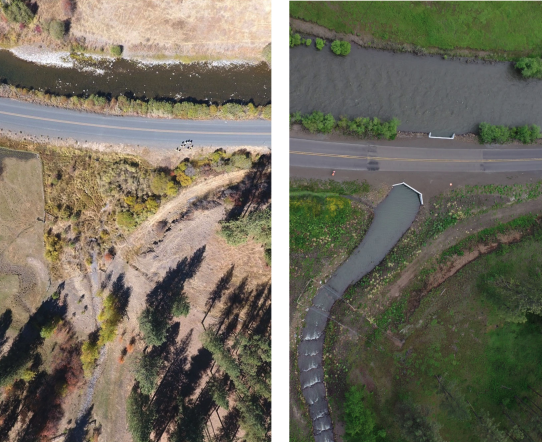ODOT’s Whisky Creek Culvert Project wins environmental excellence award
Published 7:00 am Saturday, August 6, 2022

- The first aerial photo above shows the confluence location before construction on Oct. 17, 2018 (left). The second (right), taken June 6, 2022, shows water flowing freely through the new culvert and weirs into the Grande Ronde.
LA GRANDE — At the confluence of Whiskey Creek and the Grande Ronde River, the traveling public and migrating fish alike are reaping the benefits of an award-winning new project.
The Whiskey Creek Culvert Replacement Project, completed in 2021, was among 14 projects nationwide honored with the 2022 Environmental Excellence Award from the Federal Highway Administration.
“It was an incredible honor,” said Paul Kennington, the Region 5 Environmental Program Coordinator for the Oregon Department of Transportation.
The FHA reached out to Kennington about the honor in April. The project was selected for its exemplary achievement in the Roadside Resource Management and Maintenance category. Kennington credited the many individuals who went “above and beyond” to make the project a success.
Out of 70 entries, ranging from infrastructure reconstruction to park and trail transformations, the Whiskey Creek Project stood out for its environmentally focused efforts to improve the state’s roads and waterways. ODOT’s mitigation project at Klamath Lake in south-central Oregon also received an award.
This nearly $1.4 million project involved the replacement of a particularly troublesome culvert under a section of the Hilgard to Ukiah Highway — Oregon Route 244 — approximately 12 miles west of La Grande.
The original culvert, a decades-old corrugated metal pipe approximately 5 feet wide, caused a slew of ecological and transportation issues.
For one, size and incorrect placement caused frequent flooding after heavy rains, rapid snowmelt, and other weather conditions. This flooding eroded the roadway and shoulder of Oregon 244 and gave rise to unsafe road conditions from ice and water on the pavement.
The old culvert was not just a public safety issue. It also took a toll on natural stream processes — especially fish passage. For Kennington and the project team, it was crucial to address the highway needs and the environmental ones, too.
“By doing both, we double the amount of benefit,” he said. “That’s really the way forward, is to look at the landscape and say, ‘What does it need?’”
Almost 16 miles of Whiskey Creek serves as a habitat for endangered Snake River Basin steelhead. Because of the high velocity of water during high flows and jump height during low flows, the culvert impeded fish passage from the Grande Ronde River to Whiskey Creek.
To address these issues, ODOT opted to replace the culvert completely and kicked off the project in 2018. Construction got underway in the summer of 2020, and crews raced against the clock to complete the project in one season.
Kennington noted that if the project had needed two construction seasons, erosion control and flood protection would have increased construction costs. In addition, fish passage could have been impeded.
From sensitive environmental resources, including wetlands and waterways, to maintaining continuous traffic flow, the project team had several components to juggle throughout the project.
The project team replaced the old pipe with a new, 22-foot-wide precast reinforced concrete box culvert. To complete the project, the department implemented temporary water management in the project area. A contractor then excavated the roadway and placed the new, larger culvert in better alignment with the confluence.
Only a portion of the project area was on ODOT land, and the team had to work with adjacent landowners to complete the rest of the project.
“Oftentimes we only have influence over a little tiny portion,” he said, noting that without landowner cooperation, it would have been impossible to connect the new culvert to the creek.
Once landowners gave the go-ahead, the project team got to work enhancing a portion of the creek with weirs — creating a fish ladder effect — to improve the grade of the creek and help migrating fish on their return journey upstream to spawn.
Several state and federal agencies were involved in the project, including the National Marine Fisheries Service, U.S. Fish & Wildlife Service, Oregon Department of Fish and Wildlife, Oregon Department of Environmental Quality, Oregon Department of State Lands and the U.S. Army Corps of Engineers.
The hydraulic design was contracted out to Keller & Associates. The fish passage portion of the project was a high priority for the ODFW and the Confederated Tribes of the Umatilla Indian Reservation.
Kennington emphasized that this project is just one of many ongoing river restoration efforts on the Grande Ronde, and that more agencies and organizations are taking note of the two-pronged approach to infrastructure development — addressing the needs of communities alongside environmental needs.
“It’s a nationwide movement,” he said. “We’re happy to be part of it.”




